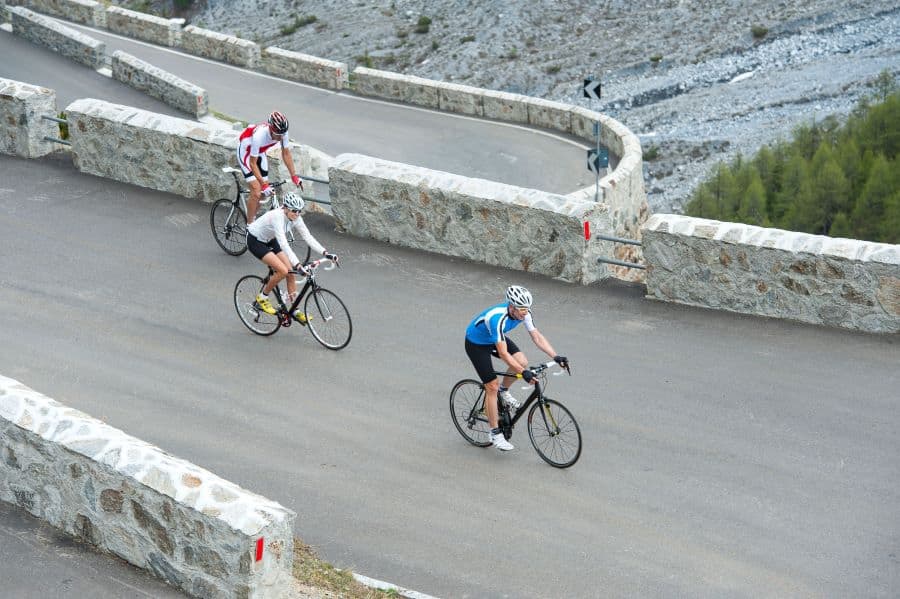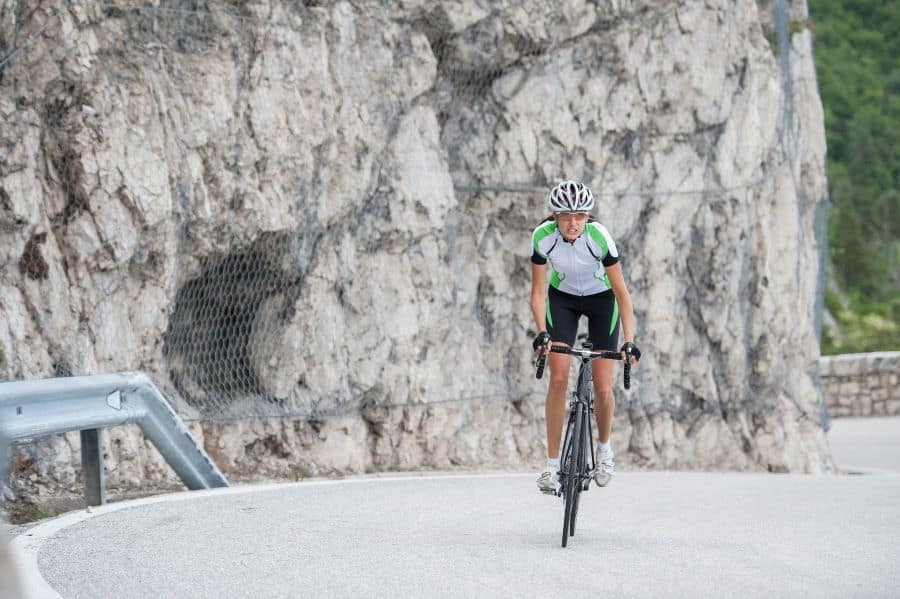This post may contain affiliate links. If you click an affiliate link and make a purchase, I may earn a commission. Also, as an Amazon Associate, I earn from qualifying purchases.--
Bike gears have one main purpose—to make your riding more efficient and comfortable. This includes riding both uphill and downhill.
However, finding out which gears to use and when to use them when it comes to riding hills can be a very frustrating experience sometimes—especially for beginners.
What bike gears to use on hills? When going up on hills, use a smaller bicycle gear. A lower gear is achieved by using a smaller chainring with a bigger cassette gear. When going down on hills, shift to higher bike gear. Higher bike gear is achieved by using a bigger chainring in combination with a smaller cassette gear.
If you are curious to learn more about how the gears on your bicycle work and develop a deeper understanding of underlying mechanics, continue reading below.

How Bicycle Gears Work
To change the gears on your bicycle, you use the shifter(s). On the shifters, often, you may find numbers corresponding to the gear you are in. ‘
Usually, the lower the number, the smaller the gear.
On most bikes, the right shifter changes the gears on the rear wheel while the left shifter operates the gears on the front wheel. This is easily remembered with the following alliteration “right—rear”. Some bicycles can have only one shifter if they have a single front chainring or no shifters at all if they are fixed-gear or single-speed bicycles.
- The chainring is the collection of gears on the front wheel. Typically there are between 1 and 3 chainrings. The smaller the cog, the easier the gear.
- The cassette refers to the whole setup of cogs and sprockets on the rear wheel. Usually, there will be between 7 and 12 cogs. The smaller the cog, the harder the gear, and the more pedaling resistance you will feel.
Usually, the gears on the rear wheel are used more often. There’s a higher number of cogs, meaning you can better fine-tune the gear resistance. In comparison, the front gears usually provide a more dramatic and noticeable change in the gear resistance.
In order to better understand which gears you need to use when riding hills you need we need to explore gear ratios.
How Gear Ratios Work
Often people can get confused as to how gears work. They are bombarded with different numbers that do not mean anything to them because they are just that—numbers.
This is why it is better to think in terms of gear ratios.
The gear ratio is a number that indicates the relation between the number of teeth on one gear to the number of teeth on another gear. In cycling, this is done by dividing the number of teeth on the chainring by the number of teeth on the cassette.
For example, a 36-tooth chainring coupled with an 18-tooth cassette will give you a gear ratio of 2. In other words, for every full turn of the crank arms, the rear tire will make two revolutions.
A gear ratio of 5 means that the rear wheel will spin 5 times for every one rotation of the pedals. This can be achieved with a 55 tooth chainring and 11 tooth cassette.
On the other hand, a 22-tooth chainring coupled with a 34-tooth cassette will give you a ratio of 0.65, which is a low gear ratio.
Lastly, we can also have a gear ratio of 1. This means that both the front cog and the rear cog have the same number of teeth. A 32-tooth chainring and a 32-tooth cassette will give you a gear ratio of 1. As you can see, this can be achieved by different gear combinations like, for example, a 24 chainring and 24 cassette, which will also give you a gear ratio of 1.
When you think in terms of gear ratios, you can see that you can achieve similar ratios with different gear combinations. In fact, there can be a lot of overlap sometimes.
Because of this overlap, people often tend to use mostly the middle chainring and only switch to the lower chainring when they need the really low gear ratios and to the bigger chainring when they need the really high ratios.
Now, let’s take a more in-depth look at what gears are often used on hills.
What bike gears to use when going uphill?
Using the wrong gear when going uphill can make riding your bicycle extremely taxing, frustrating, and you can literally grind to a halt.
When going uphill on a bicycle, make sure you are using a lower gear ratio. A lower gear ratio can be achieved by using a lower number gear or a smaller chainring and a bigger cog on the cassette. (Source)
Lower gearing is easier and less fatiguing. It requires less leg strength to keep your cadence up—it is more a question of endurance than sheer strength and muscle power.
The average gear ratio most riders enjoy going with, which is also often used in prebuilt bikes, is 48/17. Some popular alternatives are 49/16, 49/13, 48/16, 46/18, 46/17, 46/16. In other words, 46 to 49 on the chainring and 16 to 18 on the cassette will meet most people’s needs.
If you don’t want to stray out too far, a 46/17 to 42/17 are good gear ratios for smaller and occasional hills.
These gear rates are considered a good middle ground that can be used in flat and hilly areas. However, they are not suitable for climbing very steep or long hills.
On really steep hills of around 8% and upwards, many riders can go with even lower gear ratios. This is why we can sometimes see gear ratios like 50/34, 40/34, 36/40, 34/36, 34/32, 34/30, 32/20.
Keep in mind that lower gear ratios will have you spinning more while requiring less effort from your legs, and your top speed will be lower.

What bike gears to use when going downhill?
A higher gear ratio is good for riding downhill as it will allow you to move at faster speeds while still being able to apply some pedal pressure. This can be achieved by using a higher front and a smaller back.
Essentially for going downhill, you want to use a chainring with more teeth and a cog with a very low number of teeth on your cassette.
In other words, the exact opposite of what is recommended for going uphill.
There is no one size fits all answer here, and the best gears for going downhill will vary somewhat between people.
On top of that, you are likely to need to shift through a few gears depending on your speed, how strong your legs are, your cadence, and the surface gradient.
However, most people find the best results with a chainring between 32 to 40 coupled with an 11-26 or an 11-36 cassette, depending on the type of bicycle and the type of surface it is being ridden on.
How to find the right gears for riding hills?
Following the above-mentioned guidelines and principles will significantly improve your enjoyment and performance while riding hills. However, the gear and gear ratios are up to personal preference.
Experiment and Practice
Experiment in order to find what gear ranges will feel most comfortable to you. These can also vary depending on the terrain gradient.
Beginners are recommended to find a place with as little traffic as possible where they can practice and get a better feel for how their bicycle moves and where the comfortable level of pedal resistance is.
If necessary, change your gears. However, keep in mind that it may not be possible to simply change your chainring and cassette. You will also have to consider the capabilities of your derailleur, and you may also need a new chain depending on how high and low you would like to go.
Don’t forget that cross-chaining can be a problem and should be avoided.
Cadence and Rhythm
When it comes to gears, we also need to take a look at cadence, which is another term for revolutions per minute (RPM).
Finding the right cadence can help you ride better and is connected to the terrain you are riding on. (Source)
That being said, it is not all about what gears you use when riding hills but how you use them and how you prepare for the hills.
As you are approaching the hill, you need to prepare for it by slowly changing your gears.
Some riders prepare by changing to a lower chainring gear, and as they start climbing, gradually move to lower rear gear.
Not everybody likes the same cadence. Some riders prefer slow, steady, and hard grinding while climbing a hill, while others enjoy sitting and spinning. You need to find what works best for you.
Resources:
- https://www.youtube.com/watch?v=YhOT5GYUZJw
- https://www.youtube.com/watch?v=_fCjqOavdks
- https://www.youtube.com/watch?v=61aPsaPO85c
- https://www.youtube.com/watch?v=qacvtrh-ot8
- https://www.youtube.com/watch?v=2qoYr34v1C0
- https://www.youtube.com/watch?v=x8LCdo3MiFE
- https://www.youtube.com/watch?v=uEHCdxCMLcM
- https://www.reddit.com/r/bicycling/comments/yngnv/single_speeders_what_gear_ratio_are_you_using/
- https://www.reddit.com/r/cycling/comments/1w8nul/gear_ratios_for_beginner/
- https://www.reddit.com/r/FixedGearBicycle/comments/2ogb1t/what_is_the_average_gear_ratio/
- https://www.reddit.com/r/FixedGearBicycle/comments/1f9lys/lets_talk_about_gear_ratio/
- https://www.reddit.com/r/MTB/comments/96jgw3/best_mtb_gear_ratio_for_climbing_for_heavy_riders/
- https://www.reddit.com/r/cycling/comments/52vkhp/gear_ratio_for_flatlandsuphill_climbs/
- https://www.reddit.com/r/cycling/comments/9ra465/question_on_gears_and_climbing/
- https://www.pinkbike.com/forum/listcomments/?threadid=178787
- https://totalwomenscycling.com/mountain-biking/mtb-gears-explained
- https://www.mtbr.com/threads/best-gear-ratio-for-climbing.794363/
- https://www.reddit.com/r/cycling/comments/589dm2/gear_ratio/
- https://www.mtbr.com/threads/gear-ratios-for-dh-fr.485600/
- https://www.reddit.com/r/bicycling/comments/4xth0t/eli5_gear_shifting_hills/
- https://www.reddit.com/r/cycling/comments/6bihpa/tips_for_going_uphill/
- https://www.reddit.com/r/bicycling/comments/2dti5t/cycling_uphill_tips/
- https://www.reddit.com/r/bicycletouring/comments/4craq2/suitable_gear_ratios_for_climbing_hills_with_a/
- https://www.reddit.com/r/cycling/comments/giz885/lets_talk_about_gear_ratios_for_road_bikes/
- https://www.reddit.com/r/cycling/comments/ary56g/gear_ratios/
- https://www.liv-cycling.com/global/campaigns/how-to-shift-gears-on-a-bike/20499
- https://www.cyclescheme.co.uk/community/how-to/how-to-cycle-up-hills
- https://www.rei.com/learn/expert-advice/bike-gears-and-shifting.html
- https://www.reddit.com/r/cycling/comments/48cyne/hill_climbing_on_a_5034t_chainset_and_an_1130t/
- https://bicycles.stackexchange.com/questions/36061/best-bicycle-for-a-moderate-to-extremely-hilly-suburbs
